The black father’s legacy is still being written a year after two Sacramento police officers killed him in his grandparents’ backyard
The streets teem with young people. Students, hundreds of them, are chanting, marching and getting noticed. People peer out of windows. A news chopper buzzes overhead. A man in a barber’s bib rushes the throng pumping his fist. He is cheered. An afternoon barfly weaving toward the crowd is waved back.
The students have protection. The students have numbers. The students have the future on their side.
On March 7, about 250 middle school, high school and college students left class and marched to the state Capitol to demand stricter law enforcement accountability following local and state decisions to clear the two Sacramento police officers who killed Stephon Clark a year ago.
The walkouts occurred during a breakneck period in Sacramento, precipitated by District Attorney Anne Marie Schubert’s much-scrutinized March 2 press conference, during which she speculated about Clark’s state of mind in the days before the unarmed father died in a hail of gunfire in his grandparents’ backyard. Shortly after Schubert’s press conference, students started planning their response.
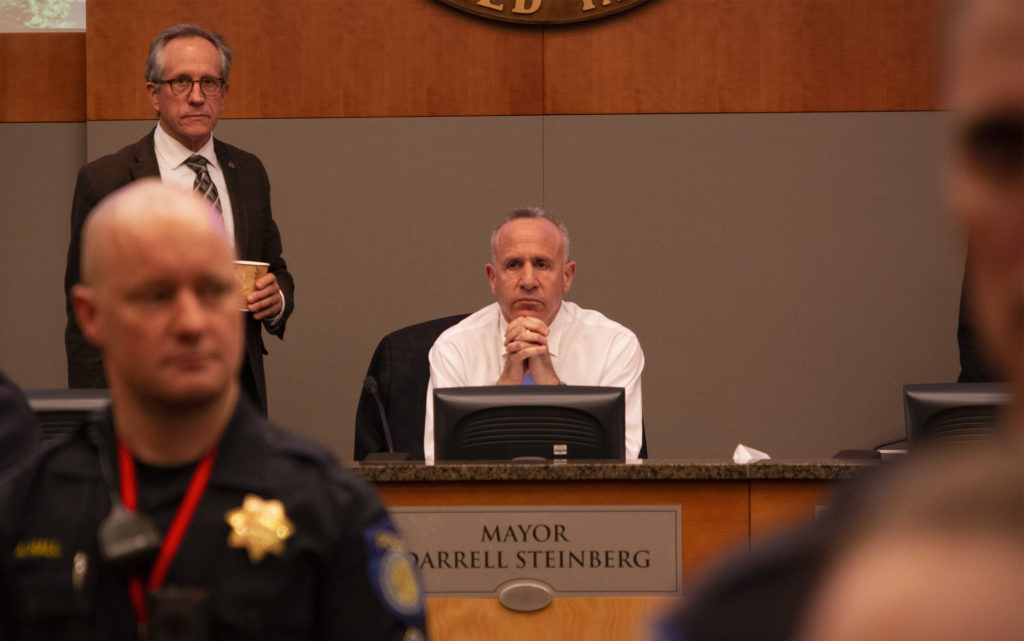
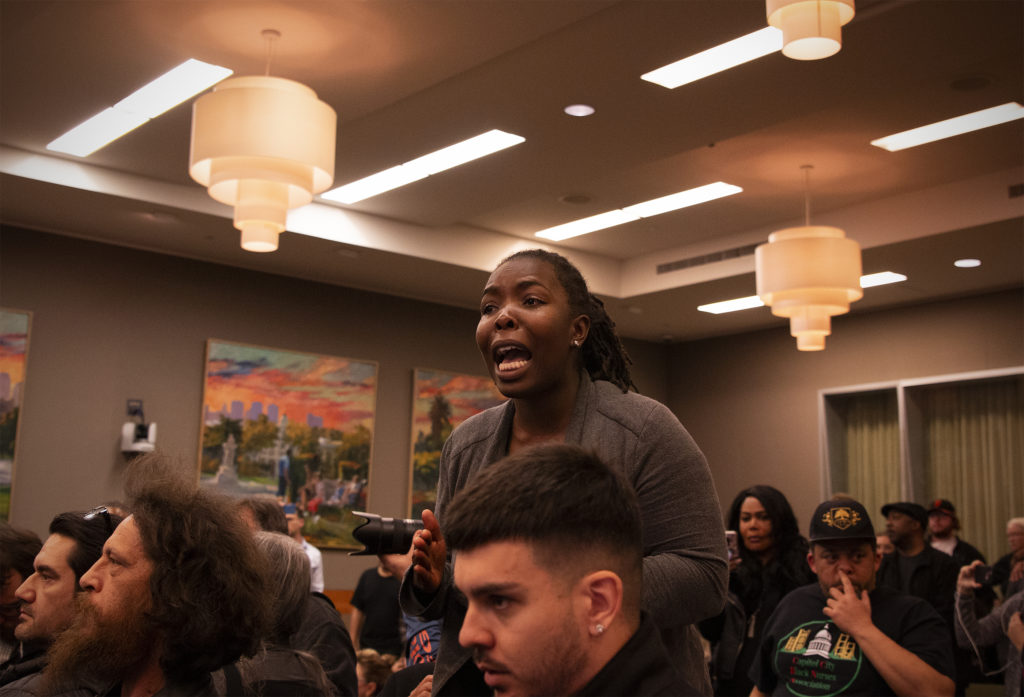
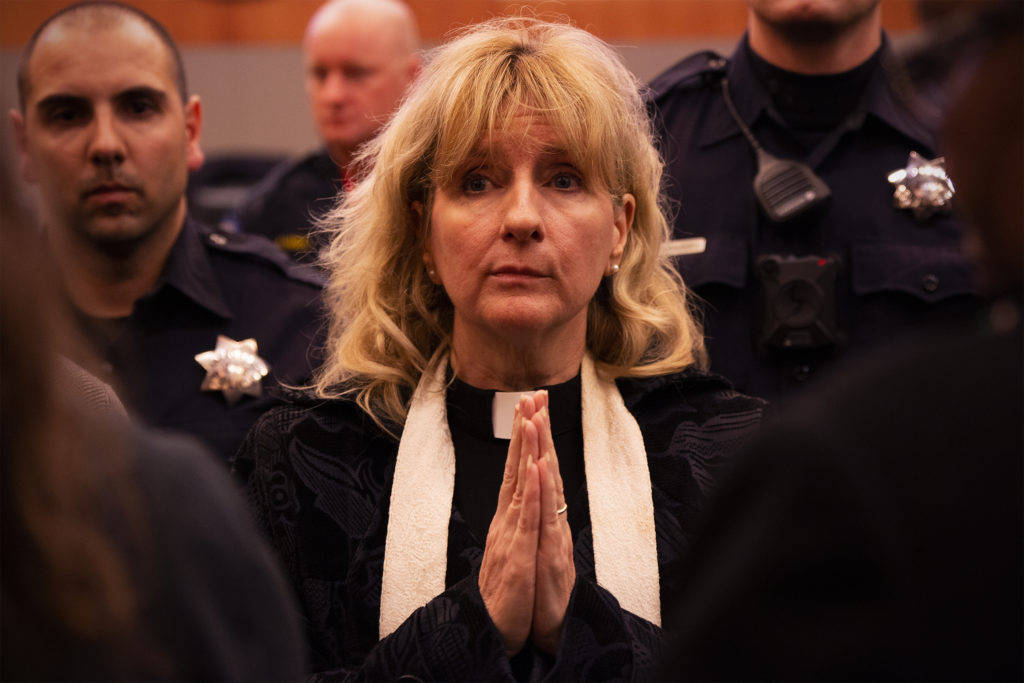
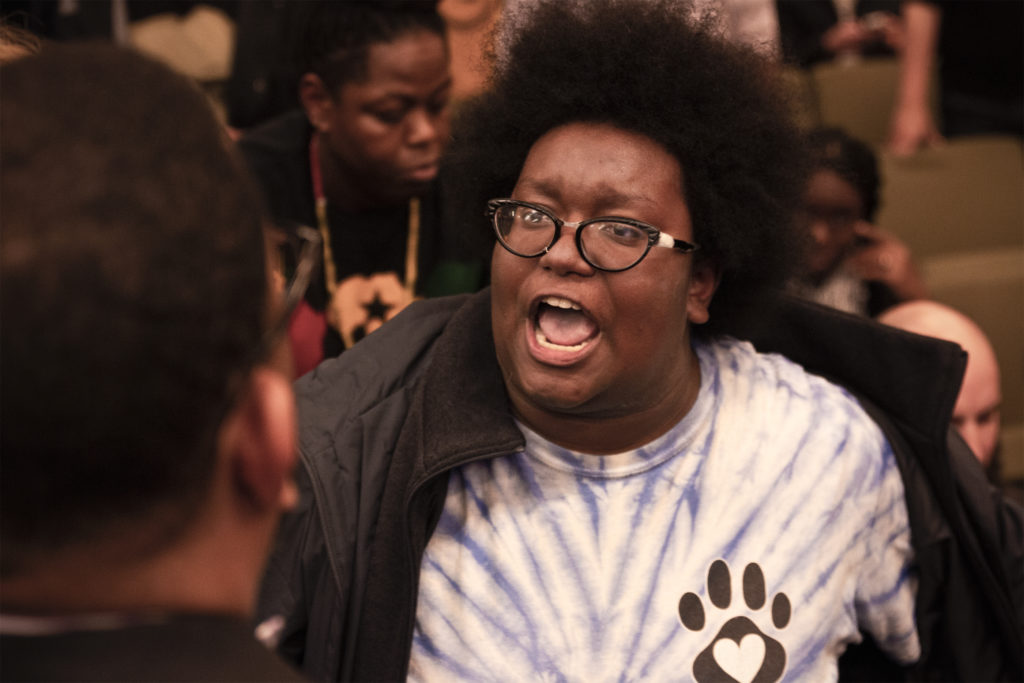
Community and clergy members on March 5 confronted the Sacramento City Council about the mass arrests of protesters the night before. (Photos by Kris Hooks)
“What’s really ignited a lot of what’s happening now, especially with our young people, is how the DA just defamed his name,” says Berry Accius, a youth mentor and community activist who helped chaperone the student march.
“All these kids of color that I mentor, these kids of color that so many of us serve, that was a direct shot at them,” Accius continues. “It wasn’t just a direct character assassination of Stephon Clark. It was a direct character assassination of all the black and brown youth that are Stephon Clark.”
If the March 18, 2018 slaying of Clark has become a watershed moment for Sacramento and California, it’s partly because of how the system has responded to it, Accius and others say. By delaying the criminal review into his death, by focusing on his personal life rather than the officers who killed him, by arresting more than 80 protesters after they disrupted an affluent East Sacramento neighborhood last week, the powers that be have helped turn a tragedy into a sustainable movement—one that may finally upend a century-old legal standard.
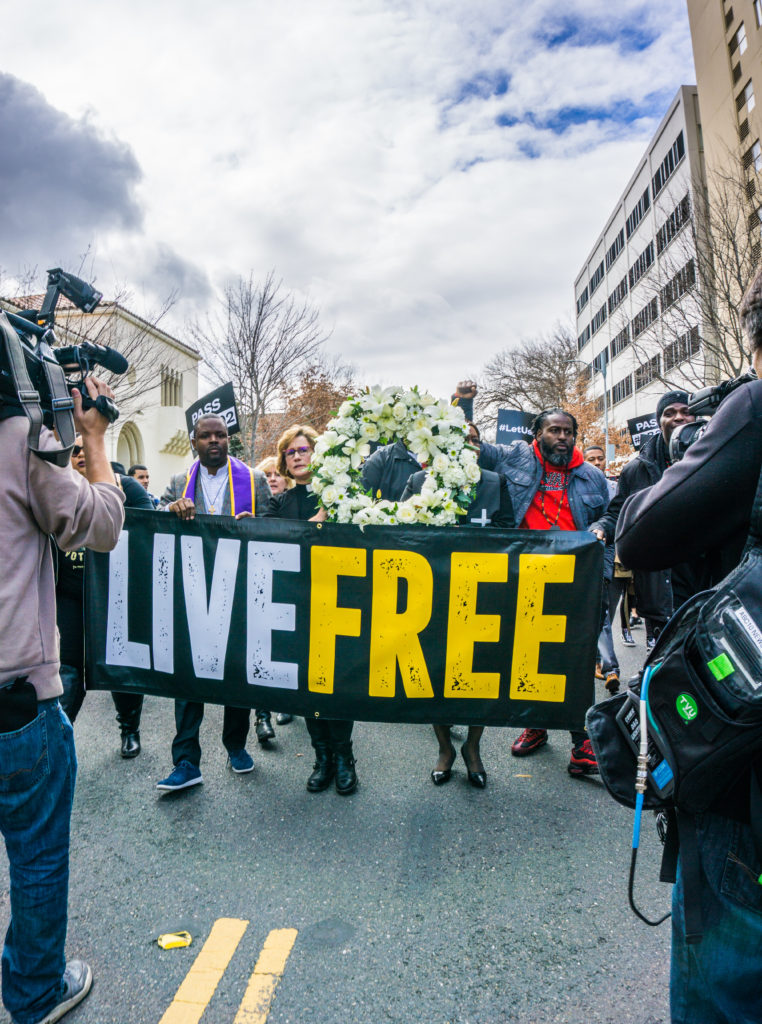
Storming the Capitol
On the western steps of the Capitol, a familiar scene: People hold signs and give the time is now speeches at a lectern backdropped by ivory columns. But this floor show is different. This floor show is for Assembly Bill 392, which would restrict when law enforcement officers can use deadly force.
Among those at the rally are South Sacramento Pastor Les Simmons and Sacramento Area Congregations Together organizer Ryan McClinton, who four days earlier were arrested for unlawful assembly in East Sacramento. (Schubert’s office announced Friday she would not file charges against any of the 84). They and other clergy and community leaders are joined by the bill’s authors, Assembly members Shirley Weber and Kevin McCarty, who pulled a similar bill last year due to law enforcement opposition.
The lawmakers’ plan was to replace their stalled bill with a compromise measure. The decision by both the DA and California Attorney General Xavier Becerra not to prosecute the officers who killed Clark, along with the mass arrests of demonstrators, emboldened Weber and McCarty to forge ahead without law enforcement’s blessing.
“We finally have the ability to talk to the powers of the state,” Weber tells the crowd.
McCarty, a former Sacramento City Council member, calls the arrests of peaceful protesters “a disgrace.” He frames AB 392 as an urgent response to current events, not ancient history. He allows that Becerra followed the book in reviewing the Clark shooting and determining no laws were broken.
“You know what that means? It’s time to rewrite the book,” McCarty says.
The press conference ends. Stevante Clark, Stephon’s older brother, makes a quick exit with his grandmother. Their part of this play is over. But a backstage show is about to begin.
Rev. Ben McBride, co-director of PICO California, a grassroots social justice advocacy group based in Oakland, gathers his flock of clergy leaders from the region. He summarizes the mission: Enter the Capitol, brace lawmakers, and get them to support AB 392 and abandon its toothless competition, Senate Bill 230. For those whose first time this is, he says, “No one ever drops in.”
He grins. That’s the point.
They breeze through the metal detectors and wade through the hall of county displays, singing “This Little Light of Mine” with modified lyrics: “I’m gonna let it shine / Until we get some justice / I’m gonna let it shine / Until we pass this bill.”
Staffers and bystanders gawk. A woman standing outside a restroom has wet eyes. A man in a long coat asks to join the mission. A short man in a clerical collar and pencil-thin mustache shrugs of course. The singing flock crams into elevators and floats to the fifth floor. In the lobby, McBride ministers calm.
“This is the people’s house,” McBride assures. “We belong here.”
He asks everyone to take a moment and think of a person lost to police violence. And, when they’re ready, to speak the name aloud.
At first they come one at a time: Alex Nieto. Oscar Grant. Johnny Douglas. Philando Castile. Mikel McIntyre. Darrell Richards. Mario Woods. Marshall Miles. Then they overlap: Dazion Flenaugh. Sandra Bland. Joseph Mann. Then they blur and repeat. Then, finally, they stop.
“Rev. Ben?”
Pastor Damian Chandler of Capitol City Seventh-Day Adventist Church requests the floor. He says a police stop with his two sons in the car got him thinking. He says he’s not here solely for his ancestors.
“The reason that I’m standing here today is not just because of Stephon Clark, but also for those who are alive,” he says. “I want to go to graduations. I want to go to my son’s wedding. I want to bless my grandchildren. And if I don’t speak out and stand for those who are living, at some point, Rev. Ben, someone’s going to call one of my son’s names.”
The group murmurs in agreement. Accius makes the pastor’s request an official motion. He invokes his daughter’s name. Chandler repeats his two sons.’ Voices overlap. Names wash together. For this moment, at least, the living still outnumber the dead.
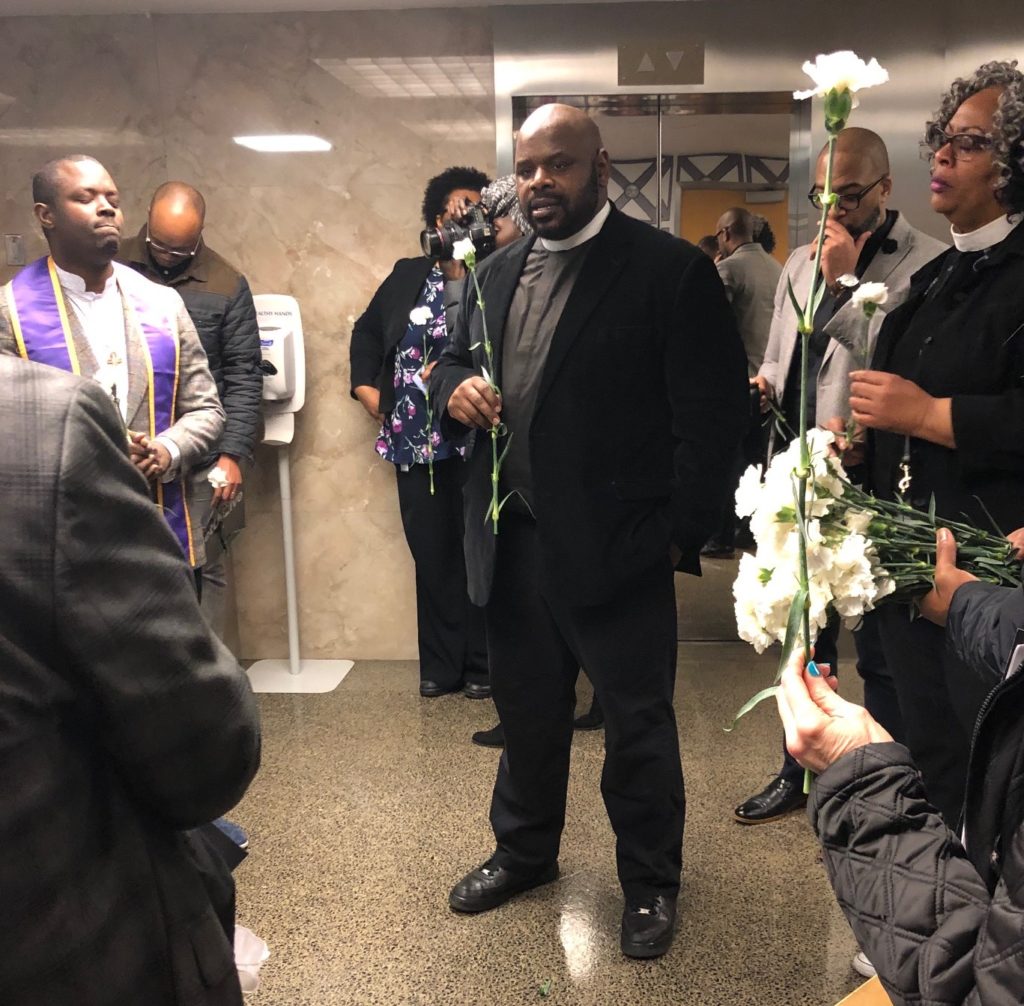
Clergy leaders plan, pray and lobby for AB 392 at the state Capitol on March 7. (Photos by Raheem F. Hosseini and Lucas Fitzgerald) 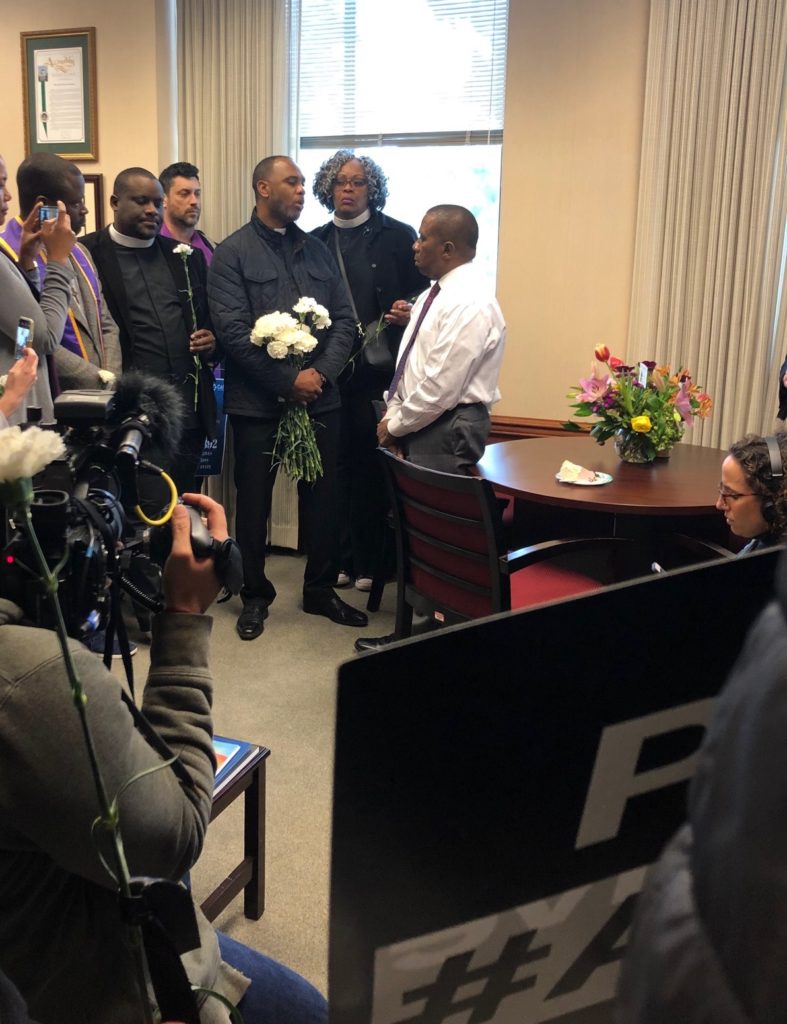
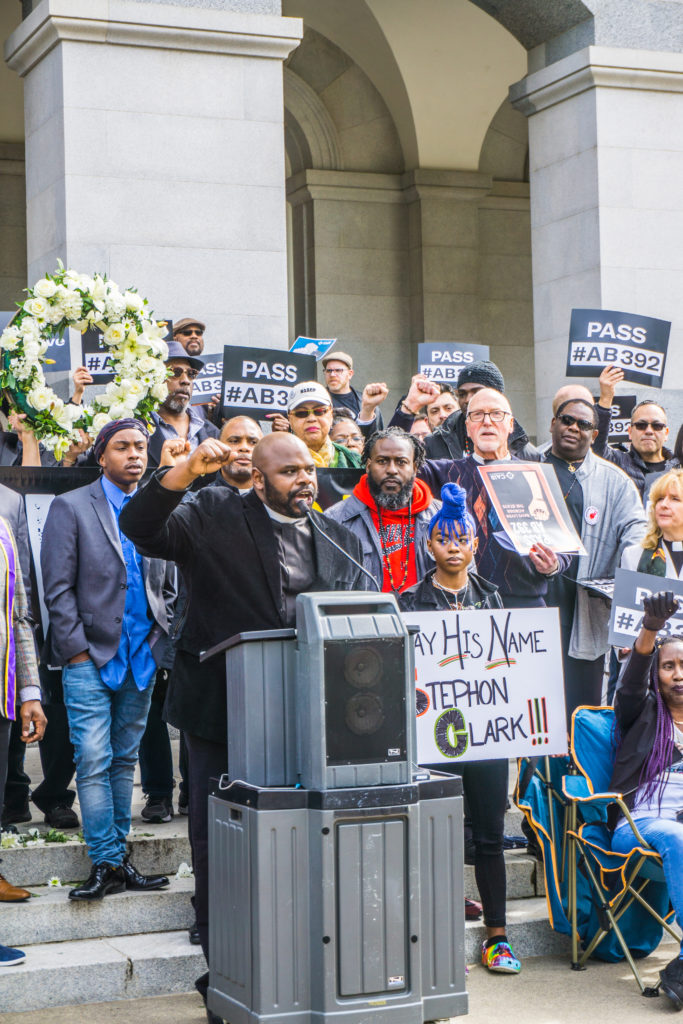
The group stops outside room 5052, first-term Sen. Anna Caballero’s office. The Central Valley Democrat is the primary author of SB 230, the Peace Officers Research Association of California’s savvy response to AB 392. Unlike the explicit reforms of the Assembly bill, its Senate counterpart calls for more training and information sharing, and the millions to fund that.
Critics of the bill say it’s an escape hatch for weak-kneed lawmakers, who want to placate their concerned constituents without alienating their generous law enforcement donors. Critics say Caballero is one of those lawmakers. She isn’t in, but chief of staff Reggie Fair is. He agrees to listen. He’s in a tie and shirtsleeves. He’s black like most of the people circling him. He says nothing as they speak.
Accius talks about consoling mothers and asks Fair if he ever worked the front lines of unquenchable grief. “I don’t believe you have because I haven’t seen your face,” Accius scolds.
Fair listens earnestly and respectfully. He holds eye contact. He lets the constituents hold court.
“Repentance means to turn away and go in the right direction,” McBride preaches to Fair. “We are calling for public repentance—the abandonment of SB 230—that will allow the free passage, and the hard work it will still take to pass AB 392.”
Someone suggests a prayer. A prayer for Fair, “to give him the boldness to stand in front of his boss.” One of the ministers palms his shoulder. Fair bows his head.
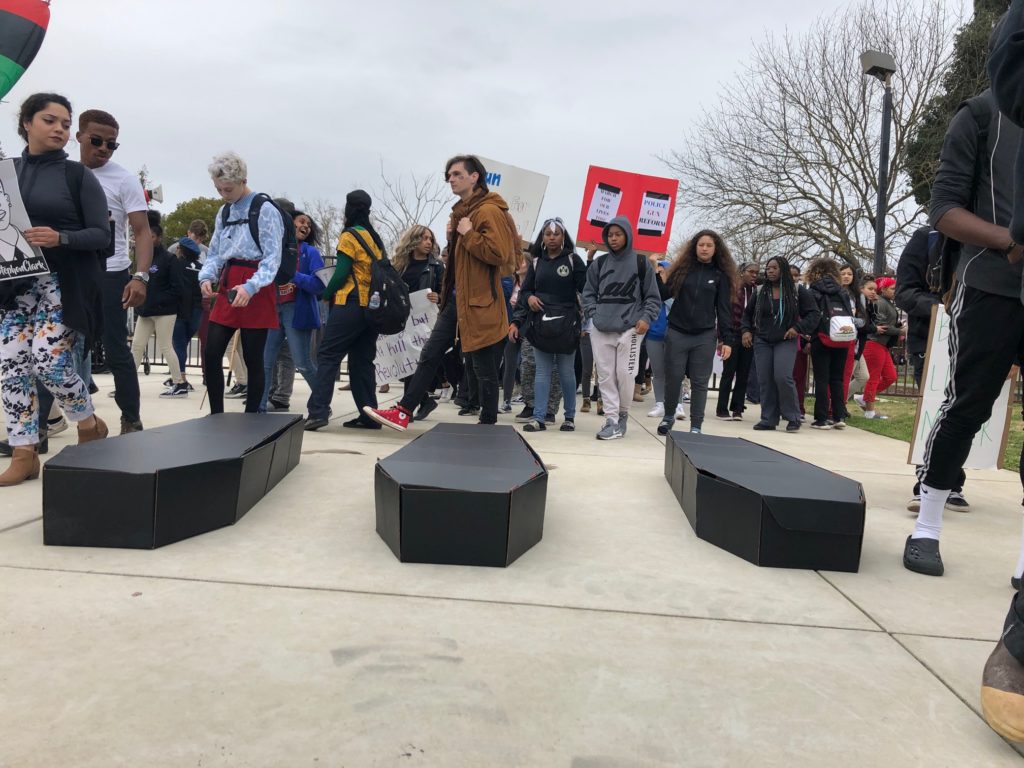
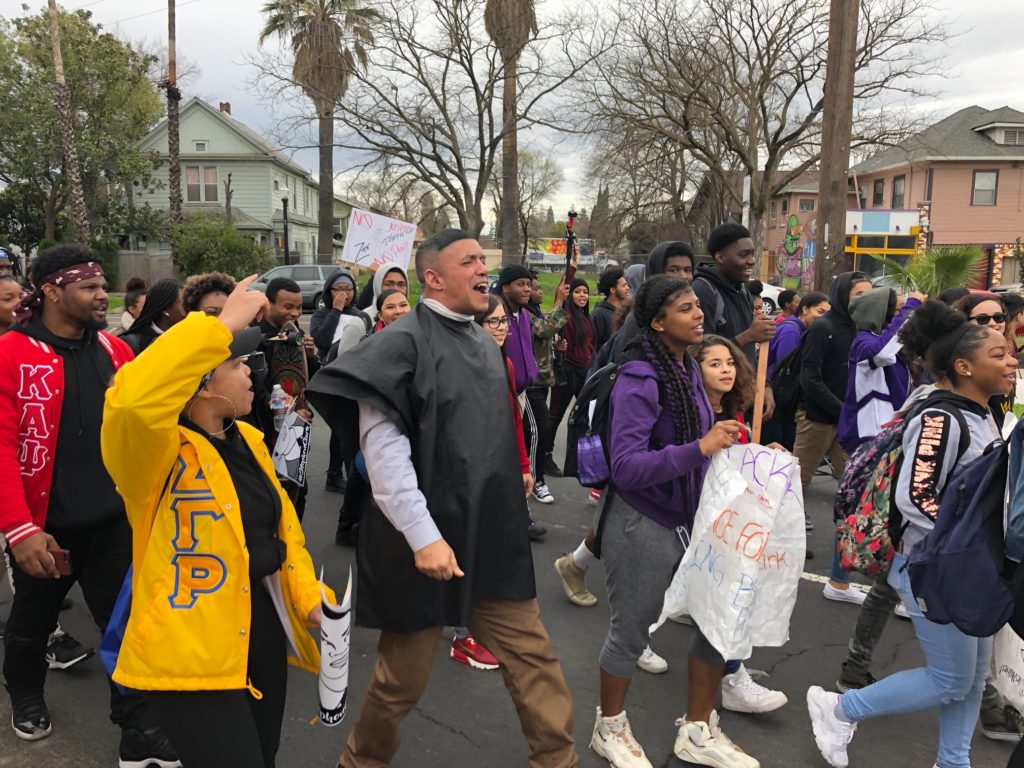
Cardboard coffins and grownup allies accent the March 7 student walkout. (Photos by Raheem F. Hosseini) 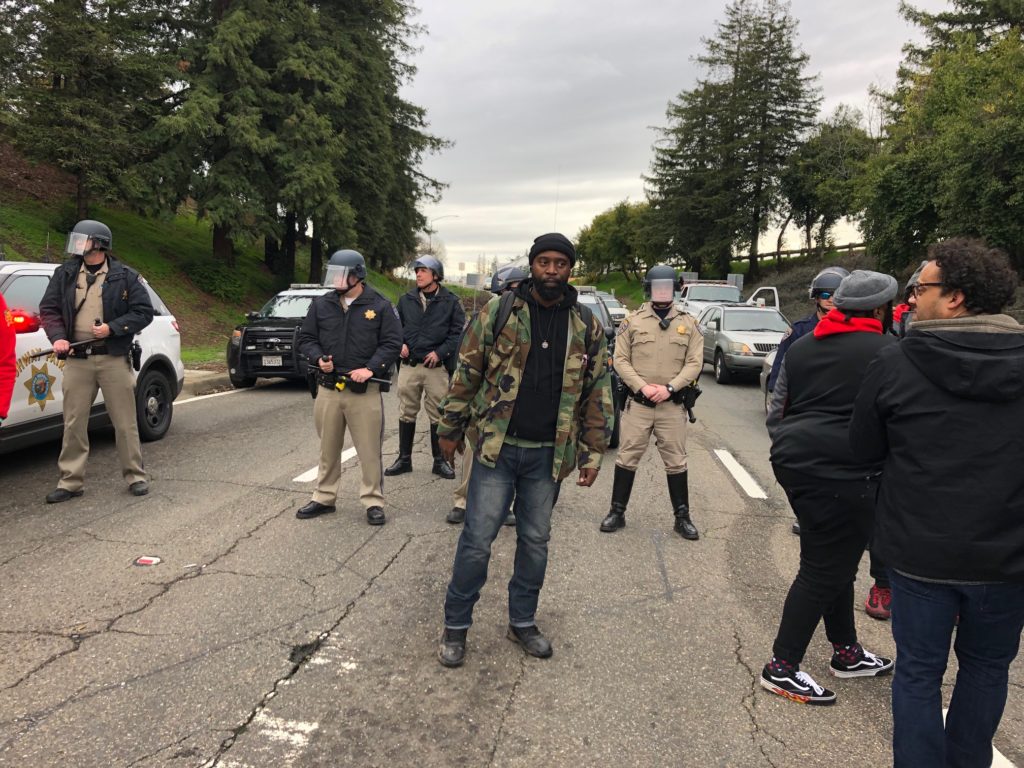
School is out
Accius and his friend Tasi Wilson book down the Senate hall, ride the elevator down and shag Accius’ truck. They rush to intercept the student march, already in progress.
The walkout, organized by the Sacramento State University Black Student Union, the Sacramento City College Black Student Union and the Next Level Advocates of Sacramento Charter High School, evokes last year’s March for Our Lives in Washington, D.C., by fusing the threats of school shootings with the police killings of unarmed black men.
“We’re just focusing on gun violence from the police side of things,” explains Jay Robb, of Sac City’s BSU.
But the student groups have other demands. Along with swift passage of AB 392, they want Clark’s killers to be fired, the DA to step down, for all local cannabis-related convictions to be expunged, for school districts to remove on-campus officers and for St. Hope to diversify its faculty at Sacramento Charter High School, which, coincidentally, is the last stop on the walkout route.
Sac State BSU leader Khalil Ferguson says their approach is deliberately pluralistic, and not solely focused on police reform. “Crime is a derivative of poverty,” says Ferguson, who holds degrees in economics and international government relations. “So the less poverty we have, the less crime there will be, the less interaction we’ll have with police, which will lead to less police killings of our people.”
Accius parks. Sac High staff and students mill in front of the gate. Wilson bides time. He’s between jobs—literally. He finished a graveyard security shift at an assisted living facility and is due at a group home in a couple hours. The latter environment puts common sense platitudes into stark relief.
“Parenting is important,” Wilson emphasizes.
He’s got two kids of his own. He recently saw a missing persons flier for a group home girl he used to know. She called him a father figure while they were playing checkers. When he announced he was taking a job elsewhere, she put her fists through the wall. That was a few years ago. Now she’s around 15 or 16 and gone.
Wilson works with boys ages 12 and up now. He says they have had trouble handling the Stephon Clark news. They carry so much lived trauma already.
A woman parks her car and pops her trunk. She brought cardboard Halloween coffins, somber totems, assembly required. Accius and Wilson trudge them to the school’s entry and drop them before four students. The students tear open the plastic bags, discard the cheesy Dracula posters and set to work.
Dozens of buoyant youth come around the corner. Their voices arrive before they do. They’ve marched for miles, their numbers growing with each school they hit. They’ve fashioned signs out of flattened Home Depot boxes taped to plywood. They’ve stenciled Stephon Clark’s likeness. They’ve handwritten slogans. “Recall DA Schubert” recurs.
They receive the parade treatment. Cops on bicycles clear a path. Cops in unmarked cars bring up the rear. Cops who get too close are shouted away by adult chaperones.
Simmons stands in the middle of 35th Street letting the youth overtake him. He beams. “This is courageous of these kids,” he says.
They take Y to Broadway and cross up numbered streets, confronting gentrified Oak Park and Highway Patrol officers along the way. Queen of Sheba Ethiopian Restaurant generously lets the students use its restroom.
The students have come from different schools and, thus, different neighborhoods. Rivalries abound, Accius says. Adults stress themselves out looking for signs of conflict. Instead, the kids unite for a single purpose.
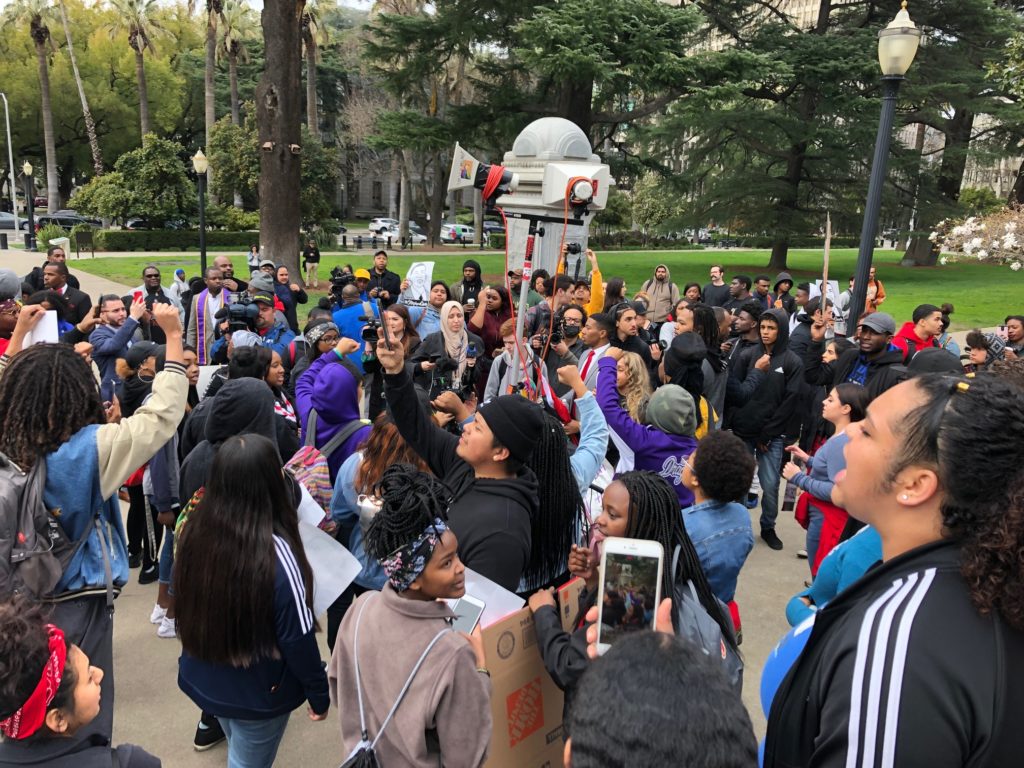
Marching north on 10th Street past Old Ironsides and Waffle Square, Alayla ribs Manuel about being new to this whole activism thing. She’s been walking since the march started at Sacramento City College; he joined two miles later at Sacramento Charter High School. At 14, she’s got more miles under her feet. At 17, he’s got fresh eyes.
He only just saw police body-camera footage of Clark’s death for the first time days earlier.
“That was just wrong,” Manuel says. “Like why would you do that? … He didn’t have no gun or anything; he just had a cellphone. So I don’t feel like that was right. I feel like Stephon Clark deserves justice.”
Accius believes the prolonged civic engagement would not be happening if Schubert rubber-stamped the Clark shooting months ago.
“We didn’t really believe that there was going to be any kind of justice in the first part with the DA,” he says. “We know the track record and we know the letter of the law. Many of us know the law. Law and humanity are two different things.
“She just flipped it and made it a lot worse by igniting a fire.”
Rather than fade over time, Clark’s name—and the community outcry over his death—continues to galvanize and mobilize. It rattles City Council chambers, fills neighborhood streets and pulses through legislative chambers. It instructs the public, who now know what the DA does and how the city manager oversees police personnel.
A year on, Stephon Clark collects new witnesses to what was done to him.
Alayla, the young-old hand, says the only way to secure justice is by showing up.
“It’s our community, it’s our schools, it’s our streets. It’s not theirs,” she says. “So if we want anything to change, we can’t sit here and expect it to change if we won’t do nothing about it.”
She and Manuel quicken their pace. They only have three blocks left to the Capitol.
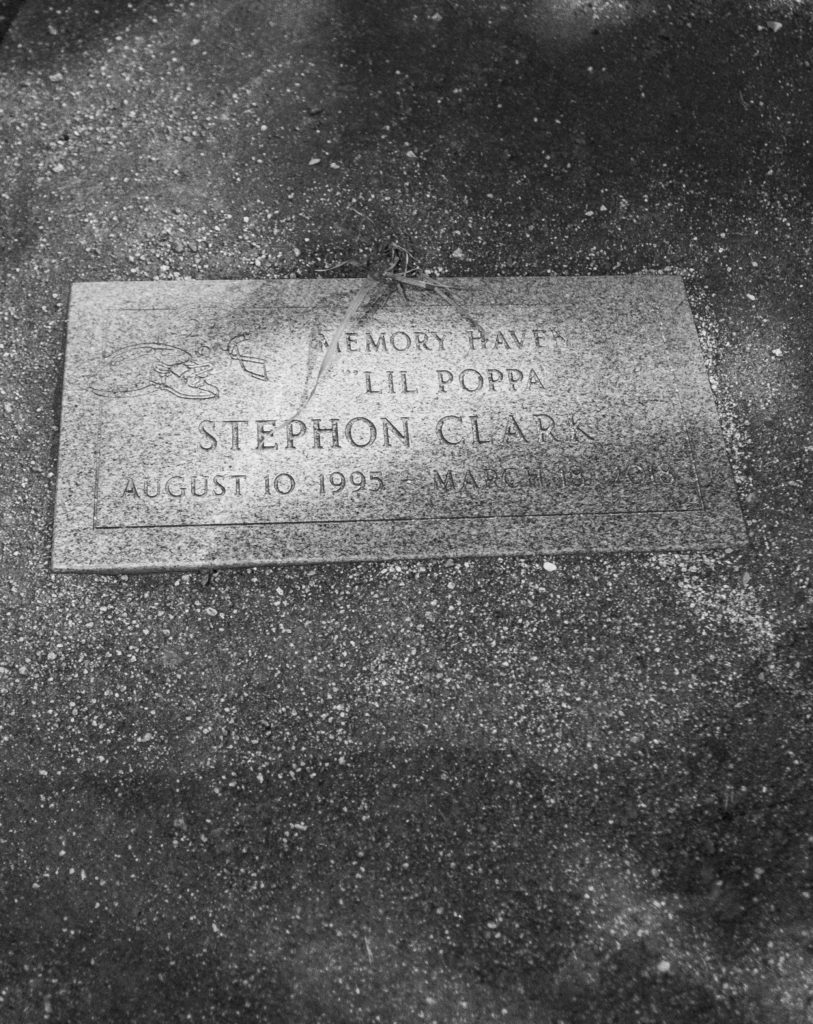
The vigil that never ends
The candlelight vigil on Friday night pauses where all this began—in the backyard where Clark died. The yard is different now. Car dealer and fellow Meadowview resident Paul Blanco, City Councilman Larry Carr, the Black Child Legacy Campaign, Sierra Health Foundation and Habitat for Humanity put the money and hours into renovating it. Gone are the uncut grass and picnic table and blood stains and bullet chips. In their place are a wooden swing, tomato plants and a tree.
But those who live inside are reluctant to enjoy it. For now, the yard is mostly for Clark, whose name is chiseled into a memorial stone in a small dirt plot.
Stevante Clark points to it and raises a microphone. He counsels the crowd against falling prey to manufactured divisions.
“It’ll tear down from the point that we’re trying to make, which is that this should not be here,” he says. “This should not be here. This should not be here. Like, I should not be talking to you all.”
He summons a brief moment of silence for his brother, then lifts his head and addresses the future.
“Now we’re going back out her in these streets yo,” he says. “And we’re gonna uplift his name. And afterwards, we’re going to keep fighting for justice. We’re going to keep fighting for accountability. We want these officers to be fired.”
The crowd of roughly a dozen says, “Yes.”
“We want the district attorney to be fired.”
“Yes!”
“We want the attorney general to be fired.”
Claps.
“And at this point, I even want [police] Chief [Daniel] Hahn to be fired.”
Cheers.
Stevante Clark leads the people away from his home and into the night saying his brother’s name. Stephon Clark no longer has a future, but he can still have a legacy.
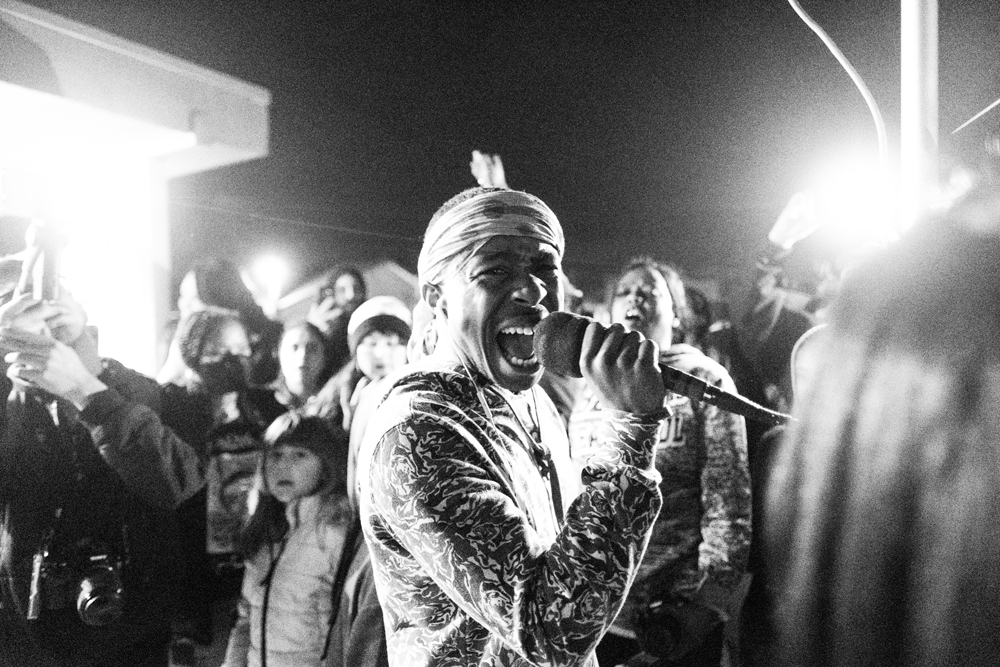
Out of his family, Stevante has probably been the most consumed with cementing that legacy.
Two days later, Stevante tells SN&R he felt that effort take a hit when Schubert used Stephon’s cellphone data to indict him as some kind of suicidal fugitive. It’s not that his family expected the DA to charge officers.
“We knew what was going to happen,” Stevante says. “I just personally didn’t expect her to drag his name through the dirt like that.”
Stevante is hoping to salvage that name in the coming days. He’s one of the architects of a legacy weekend, which begins this Friday night with a teen summit and culminates Monday, on the one-year anniversary of his brother’s death, with a remembrance at Genesis Church in Meadowview.
“That is just the beginning of what I’m trying to do,” says Stevante, who sits on the city’s Measure U review committee and has flirted with running for mayor.
He expects his brother’s legacy to encompass legislative and policy changes. He doesn’t expect it to end there. But he also plans to take a step back after the legacy weekend, out of a whirlwind that hasn’t eased up since March 18, 2018.
“There hasn’t been a day since March 18th where his name hasn’t come up. And sometimes that can be a lot,” Stevante says. “Everything stopped when Stephon died. My whole life stopped.”
He aims to rekindle that life, to record music again as Pharoah Davinci, to reclaim his own image that was unfairly posterized by a council meeting outburst, and to find a balance that has eluded him since 18 shots sailed through his grandparents’ backyard. He has many oaths—to his brother, his community and himself. He’s learning how to keep them all.
“That’s what I’m trying to figure out,” Stevante says.

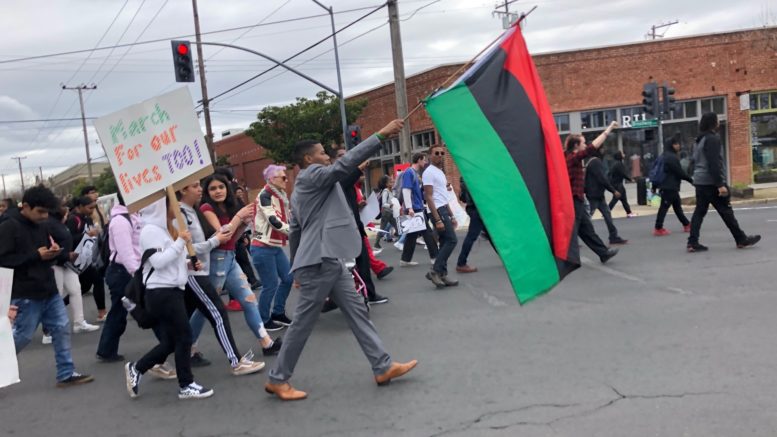

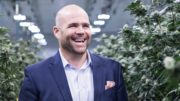


Leave a comment